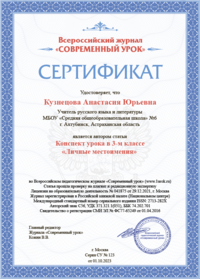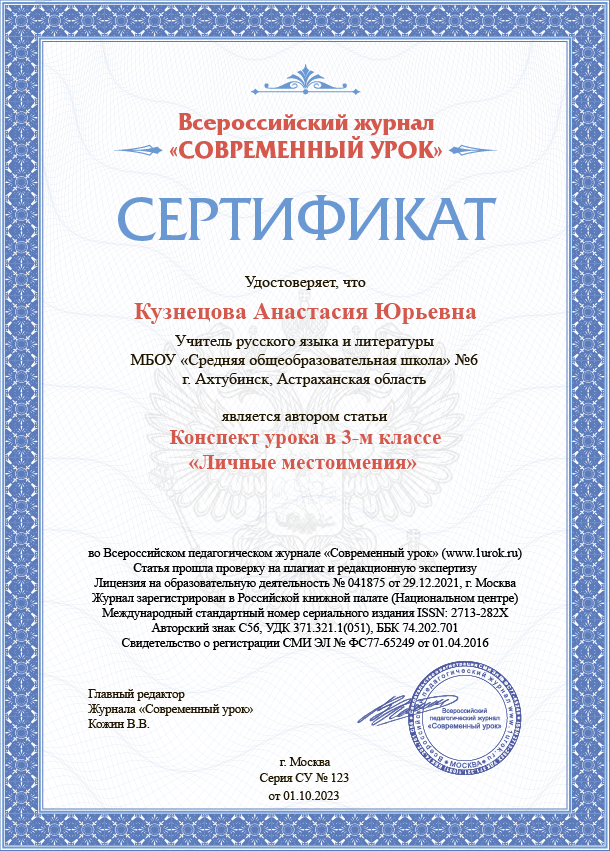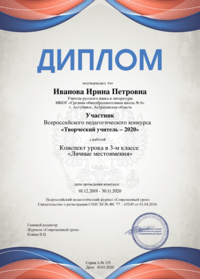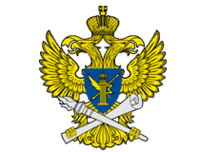The World of Animals
Автор: Михалёва Ольга Викторовна
Организация: МОУ СОШ «Перспектива» г.о. Власиха Московской области
Населенный пункт: Московская область, г. Власиха
Цель урока: закрепить знания обучающихся по лексическому и грамматическому материалу модуля.
Задачи:
- Познавательный аспект – расширить знания обучающихся о жизни животных всего мира, научить применять свои знания на практике
- Развивающий аспект – развить умения строить общение на заданную тему
- Воспитательный аспект – привить любовь и толерантное отношение к миру животных, сформировать интерес и стремление защитить животных под угрозой вымирания
- Учебный аспект – повторить материал по теме модуля, закрепить знания по теме Настоящее Простое (Present Simple), развить речевые умения, навыки чтения, аудирования и письма
Оснащение урока: парты расставлены для 3-х групп учащихся, фотографии и картинки с видами животных, прикрепленные к стенам классной комнаты, УМК «Английский в фокусе», презентация PowerPoint, задания и информация для урока на электронных носителях и карточках, компьютер, лазерная указка, мультимедийный проектор, призы, жетоны, карточки со смайликами для рефлексии.
Ход урока
I. Организационный момент
1. Приветствие.
Teacher: Good morning! Good morning! Good morning to you! Good morning! Good morning! I am glad to see you!
Children: Good morning! Good morning! Good morning to you! Good morning! Good morning! We are glad to see you!
Teacher: Sit down, please! Let's start our lesson. I hope, you are fine today. We have an unusual lesson. As you can see, we have a guest. Her name is... Let's greet our guest. Good morning, ...! Children: Good morning, ...! 2. Беседа о дате и дне недели. Определение темы урока и плана работы.
- What date is it today? Children: It's the 31 st of January. Teacher: What day of the week is it today? Children: It's Friday. Teacher: Who's absent today? Children: All are present/ ... is absent. Teacher: What's your homework? Children: A project about animals. Teacher: All right. Thank you. Children! Look around! What can you see on the walls?
Children: Animals. Teacher: Do they live in one country or in different countries of the world? Children: In different countries. Teacher: How do you think what is the topic of our lesson today? What are we going to talk about? Children: The World of Animals/ About animals. Teacher: Well done! Today we are going to speak about a large world of different animals. You are going to take part in different competitions. So you are going to work in groups. Look there! What animals are there? (Обращается к группе учащихся, сидящих за первым столом. Показывает лазерной указкой на картинки с изображением диких животных.) Children: "Wild Animals" Teacher: Right you are! So, your team is "Wild Animals" (Учитель ставит табличку на стол группы.) What animals can you see on that wall? (Обращается к другой группе учащихся. Показывает лазерной указкой на картинки с изображением животных с фермы.) Children: "Farm Animals" Teacher: Good! And your team is "Farm Animals" (Учитель ставит табличку на стол группы.) Now look there! What kind of animals can you see? (Обращается к третьей группе учащихся. Показывает лазерной указкой на картинки с изображением домашних питомцев.) Children: "Pets" Teacher: Right you are! So, the third team is "Pets". (Учитель ставит табличку на стол группы.)
II. Фонетическая зарядка.
Teacher: Now let's do phonetic drills! Repeat after me!
[f] fox, frog, fish, wolf.
[r] rat, parrot, zebra, frog
[au] mouse, round, cow, house
[æ] My cat is black and fat. My cat likes rats. Rats are fat.
- (Повторяют за учителем слова и скороговорку.) Teacher: Now read the words! Read the tongue-twister! (Читают самостоятельно слова и скороговорку .)
III. Речевая зарядка в форме игры.
1). Teacher: Good job! Please, look at the picture of a strange animal! What animals can you see here? Say like that: "I can see a wolf in the picture."
- An elephant 2. A tiger 3. A pig 4. A rabbit 5. A kangaroo 6. A giraffe 7. A frog 8. A dove/ A bird Children: (Называют животных по очереди, части которых они видят на изображении слайда.) Teacher: Well done!
IV. Аудирование песни и обсуждение услышанного.
- And now listen to the song and sing along! Try to remember the animals. Children: (Слушают и подпевают песню "Простая песенка на английском про животных". Запоминают животных из песни: a dog, a cat, a mouse, a bird, a fish, a lion.)
- https://www.youtube.com/watch?v=PU_5YiOfIlw Teacher: Name the mentioned animals, please! Children: A dog, a cat, a mouse, a bird, a fish, a lion. Teacher: What are they? Children: Pets. Teacher: Can lions be good pets? Children: No, they can't. Teacher: Why do you think so? Children: They are wild and dangerous animals. Teacher: Yes. You are right.
V. Тренировка лексических единиц по теме.
1). Логические цепочки слов.
Teacher: Look at chains of words. One word in each chain is wrong. Cross out the odd word in each chain.
Children: (Команды по очереди называют лишнее слово в цепочке.)
- Hyena, tiger, lion, panda, leopard. 2. Dolphin, camel, whale, crocodile, penguin. 3. Cow, horse, pig, sheep, hen.
2). Решение чайнворда.
Teacher: Look at the chainword! Find as many words as you can. Children: (Учащиеся находят слова и обводят их на листах.)
Wolf, fish, shark, kangaroo, owl, leopard, dog.
3). Анаграммы.
Teacher: Write the names of the animals correctly. Children: (Учащиеся заполняют карточки.)
god, nilo, getir, nomeky, omuse, sohre, rabe, shpee
dog, lion, tiger, monkey, mouse, horse, bear, sheep
4). Загадки о животных.
Teacher: Guess! What animal is it? Children: (Команды по очереди разгадывают загадки о животных.)
- This animal is cute. It lives in Australia. It likes eucalyptus leaves. (Koala)
- This huge animal has a long trunk, tusks and big ears. It lives in Africa. (Elephant)
- This animal lives on a farm. It eats grass and gives milk. (Cow)
- This animal can live without food and water for three weeks. It has a hump on its back. (Camel)
- This animal has got a beautiful white skin with black stripes. It’s like a horse but lives in Africa. (Zebra)
- This animal has a thick mane around its neck. It’s the king of the animal world? (Lion)
VI. Физкультминутка. "Yes, I Can! | Animal Song For Children | Super Simple Songs"
https://www.youtube.com/watch?v=_Ir0Mc6Qilo
Teacher: Let's relax! Children: (Учащиеся выполняют движения под музыку.)
VII. Отработка навыков диалогической речи в форме игры.
- Well done! Now let's play! You have to ask me questions and guess what animal there is in the box. Use only general questions like that: Is it fat/ green/ a frog? Has it got a hump/ long ears? Does it live in trees? Children: (Команды угадывают животное в "Чёрном ящике", задавая общие вопросы по очереди.) - A small white cat. Teacher: We can see a small white cat. It's cute and soft. It drinks milk and eats fish and meat. It lives at home. It's a pet.
VIII. Работа с текстом о крупных кошках.
Teacher: Right now we are going to read a text about other animals. After that be ready to discuss it. Children: (Учащиеся читают текст по предложению по цепочке.)
Big cats live all around the world. They have sharp claws and teeth. They can be dangerous to people. Many people hunt big cats for their fur and even just for fun. Here are some of the most famous big cats.
The lion is the loudest of all big cats. Lions live in families called prides. There are usually around 15 lions in one pride. Lions hunt late in the evening or early in the morning. They kill antelopes and zebras. Lions live in Africa and Asia.
The biggest cats are tigers. They are strong. Tigers can weigh up to 220 kilograms. These animals come from India and they usually live alone. They are very good climbers and swimmers. They can eat 30 kilograms of meat a day. Now there are only 2, 500 tigers.
- Choose the best heading to the text: A. The biggest cat is the tiger. B. The biggest cat is the lion. C. The most famous big cats. Children: (Выбирают заголовок для текста.) C. Teacher: Find the verbs in Present Simple in the 1st paragraph of the text. Children: (Находят глаголы в Present Simple.) live, have, hunt. Teacher: Say if the sentences are True, False or Not Stated. Correct the False ones. Children: (Высказывают свое мнение о правильности предложений из текста. Исправление неверных предложений.)
- Big cats live in Africa. (F - Big cats live all around the world.) 2. People hunt them because they are funny. (F - People hunt them for their fur.) 3. Tigers live in big families. (F - They usually live alone.) 4. Lions live in prides. (T) 5. Tigers swim very well. (T) 6. Lions can weigh up to 300 kilograms. (NS) Teacher: Answer the questions. Children: (Отвечают на вопросы.) What are some of the most famous big cats? (They are lions and tigers.) 2. Where do they live? (They live all around the world.) 3. Why do people hunt big cats? (They hunt them for their fur and even just for fun.) 4. Do lions or tigers live in prides? (Lions live in families called prides.) 5. What big cats are very good climbers and swimmers? (They are tigers.) 6. How much meat do tigers eat a day? (They can eat 30 kilograms of meat a day.)
VIII. Монологические высказывания учащихся о животных.
1). Контроль выполнения домашнего задания: проект о животном.
- Let's check up your homework and listen to your stories about animals. What are your stories about? (1 проект от группы послушать, остальные проверить после урока.) Children: About a dog/ a lion... (Представляют классу проекты, подготовленные дома.)
2). Собрать паззл из разрезанной картинки с изображением животного и дать его описание с опорой на предложенные факты.
- Now take pieces of a picture. Do puzzles and speak about the animals. Children: (Собирают части изображения животного, приклеивают их к листу и представляют классу свои проекты о животных с опорой на данные факты.)
IX. Подведение итогов урока. Рефлексия.
Teacher: Thank you for your answers. Let's count your tokens/ badges. How many of them do you have? Children: (Команды подсчитывают количество жетонов. Определяется победитель соревнования.) 12/7... Teacher: Let's summarize our work. Children: I know the names of animals. I can read and speak about animals. I can ask and answer questions. Teacher: How do you feel? Show the picture with a smile, if you are happy, or a sad one, if you are sad. Children: (Показывают смайлик с изображением их чувств.)
X. Определение домашнего задания на следующий урок.
Teacher: Your homework is SB p76 ex 1, p 77 ex 4

 БЕСПЛАТНЫЕ семинары
БЕСПЛАТНЫЕ семинары





